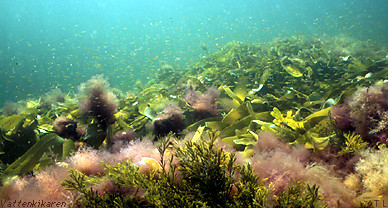 |
|

But the
variety of specie
is relatively great along rocky coastlines and the production of new organic
material can also be great. The production per area that takes place in
the kelp forests is amongst the
highest ever measured in any environment.
Exact measurements on the different types of rocky beaches
and under varying conditions unfortunately are lacking in Swedish waters.
We know for example very little about the quantities of biomass in the
different environments and how much is produced during a certain time
period. Little is known about how much biomass is brought into the beach
environment, how much is taken away, and how much is consumed by grazers
and predators.
However, we do know alot about certain beach organisms,
their eating habits and distribution, aswell as how currents and waves
transport nutrients. This information can be used to construct simplified
pictures of how organisms relate to each other on wave
exposed and protected rocky
beaches and what cooperation prevails between rocky coastlines and other
environments.
 |
Page 48 of
52 |
 |
|



